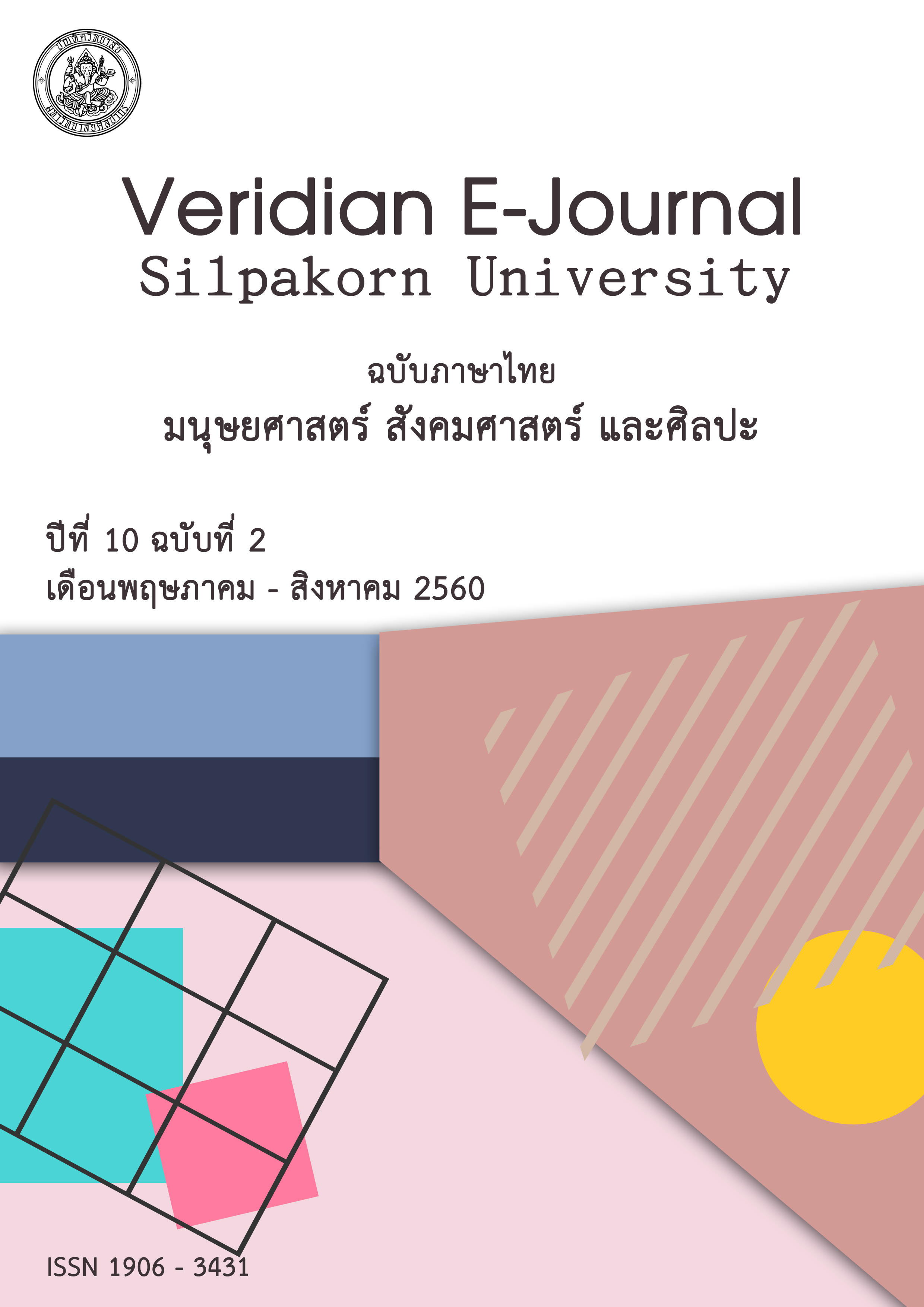การวิเคราะห์ความสัมพันธ์เชิงสาเหตุความสุขในชีวิตสมรส ในเขตกรุงเทพมหานคร
Main Article Content
Abstract
การวิจัยครั้งนี้เป็นการพัฒนาโมเดลโครงสร้างความสัมพันธ์เชิงสาเหตุของความสุขในชีวิตสมรสใน เขตกรุงเทพมหานคร โดยมีวัตถุประสงค์ 1) เพื่อศึกษาและพัฒนาโมเดลเชิงสาเหตุความสุขในชีวิตสมรส 2) เพื่อตรวจสอบความสอดคล้องของโมเดลเชิงสาเหตุความสุขในชีวิตสมรสที่พัฒนาขึ้นกับข้อมูลเชิงประจักษ์ กลุ่มตัวอย่างที่ใช้ในการศึกษาคือ สามี-ภรรยา ช่วง 1-5 ปีแรกหลังการแต่งงาน จดทะเบียนสมรสอย่างถูกต้องตามกฎหมาย ในเขตกรุงเทพมหานคร จำนวน 400 คน โดยวิธีการเลือกตัวอย่างแบบหลายขั้นตอน (Multistage Random Sampling) เครื่องมือวิจัยที่ใช้ในการเก็บรวบรวมข้อมูล คือ แบบวัดความสุขและปัจจัยเชิงสาเหตุ ที่มีอิทธิพลต่อความสุขในชีวิตสมรส แบ่งออกเป็น ความสุขในชีวิตสมรส, ปัจจัยด้านท่าทีการสื่อสารในชีวิตสมรส, ปัจจัยด้านการสร้างความสัมพันธ์ในชีวิตสมรส และปัจจัยด้านการสร้างความคาดหวังในชีวิตสมรส มีค่าความเชื่อมั่นที่ .96, .87, .84 และ .96 ตามลำดับ สถิติที่ใช้ในการวิเคราะห์ข้อมูล ได้แก่ ค่าเฉลี่ย ค่าร้อยละ ค่าส่วนเบี่ยงเบนมาตรฐาน การวิเคราะห์สัมประสิทธิ์สหสัมพันธ์แบบเพียร์สัน และการวิเคราะห์โครงสร้างความสัมพันธ์เชิงสาเหตุ
ผลการวิจัยพบว่า 1) ปัจจัยเชิงสาเหตุที่มีอิทธิพลต่อความสุขในชีวิตสมรส ประกอบด้วย การสร้างความสัมพันธ์ในชีวิตสมรส ความคาดหวังในชีวิตสมรส และท่าทีการสื่อสารในชีวิตสมรส ซึ่งพบว่า ความสุขในชีวิตสมรสได้รับอิทธิพลทางตรงเป็นบวกจากปัจจัยด้านการสร้างความสัมพันธ์ในชีวิตสมรสสูงสุด มีค่าอิทธิพลทางตรงเป็นบวกเท่ากับ .90 รองลงมาเป็นปัจจัยด้านความคาดหวังในชีวิตสมรส มีค่าอิทธิพลทางตรงเท่ากับ .66 และได้รับอิทธิพลทางตรงเป็นลบจากปัจจัยด้านท่าทีการสื่อสารในชีวิตสมรส มีค่าอิทธิพลเป็นลบเท่ากับ - 0.50 ตามลำดับ และความสุขในชีวิตสมรสยังได้รับอิทธิพลทางอ้อมเป็นบวกจากท่าทีการสื่อสารในชีวิตสมรส มีค่าอิทธิพลเท่ากับ 0.68 นอกจากนี้ สามารถพิจารณาค่าอิทธิพลของโมเดลความสัมพันธ์เชิงสาเหตุของความสัมพันธ์ในชีวิตสมรส ได้รับอิทธิพลเป็นบวกจากท่าทีการสื่อสารในชีวิตสมรส มีค่าอิทธิพลเป็นบวกเท่ากับ 0.61 ส่วนค่าสัมประสิทธิ์พยากรณ์ พบว่า การสร้างความสัมพันธ์ในชีวิตสมรส ความคาดหวังในชีวิตสมรส และท่าทีการสื่อสารในชีวิตสมรส สามารถอธิบายความสุขในชีวิตสมรสได้ร้อยละ 50 (R2=.50) 2) ผลการตรวจสอบความกลมกลืนของโมเดลกับข้อมูลเชิงประจักษ์ในดัชนีกลุ่มสัมบูรณ์ พบว่าค่า Chi-square 50 (R2=.50) 2) ผลการตรวจสอบความกลมกลืนของโมเดลกับข้อมูลเชิงประจักษ์ในดัชนีกลุ่มสัมบูรณ์ พบว่าค่า Chi-square ( ) = 58.10,df = 44, p =.10, ค่า GFI = .98, ค่า AGFI = .95, ค่า RMSEA = .04, ค่า SRMR = .04 = 58.10, ส่วนในดัชนีกลุ่มเปรียบเทียบ พบว่า ค่า CFI = 1.00 เมื่อพิจารณาตามเกณฑ์ความสอดคล้อง พบว่า ค่า Chi-square ( ) ไม่มีนัยสำคัญทางสถิติ และดัชนีอื่นๆ ชี้ให้เห็นว่าโมเดลตามสมมติฐานมีความสอดคล้องกลมกลืนกับข้อมูลเชิงประจักษ์
This research aims to develop a model of causal relationship of happiness in marriage early In Bangkok area. The objectives are to study: 1) to study and develop a causal model in a happy marriage, 2) to determine the consistency of developed causal model in happy marriages based on empirical data. The samples used in this study are husbands and wives, who completed marriage registration and live together in Bangkok. The total of 400 samples are selected by Multistage random sampling. Research tools that are used to collect data is a causal factor measurements towards marital happiness. Research tools used in collecting data is a measure of happiness and causal factor towards marital happiness, which divided as a measure of happiness, survival stance measurement of manner in dealing with the problem, measured in building marital relationships and marital expectations. The conviction value is 0.96, 0.87, 0.84 and 0.96 respectively. The statistic data used in data analysis are average, percentage and standard deviation values. The analysis model are the Pearson correlation analysis to model and the structural analysis of a causal relationship.
The results of research showed that: 1) Factors influencing happiness in marriage consists of expectations in a marriage, marriage relationship and survival stance in their marriage, which found happiness in marriage influenced positively toward the higher marriage relationship. The direct effect is positive and equal to .90. A minor factor is that expectations in marriage have the direct effect value equal to 0.66 and influenced negatively from the personality of survival stance at the coefficient of -0.50, respectively. Moreover, happy married life influenced indirectly and positively to personality to deal with the problem. The influence coefficient is 0.68. The influence coefficient of the model of causal relationship of marital relationships can also be considered having positive influence from the personality to deal with the problem. With positive influence coefficients of 50 (R2=.50) 2) Results of monitoring the merging of models with empirical data in the index group showed the Chi-square = 58.10, df = 44, p = 0.61, value. GFI = 0.98, the AGFI = 0.95, the RMSEA = 0.04, the SRMR = 0.04. In the index of comparison group, found that the CFI = 1.00, based on consistent criteria that the Chi-square. There is no statistically significant and the other indexes suggests that the models based on the assumptions are in harmony with the empirical data.
